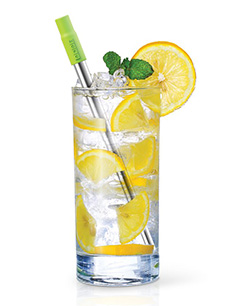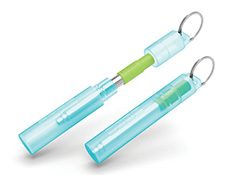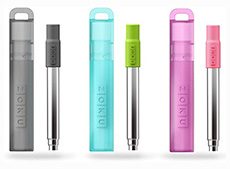STOCKING STUFFER: Zoku Pocket Straw
|
Americans use millions of plastic straws each day. Plastic drinking straws are among the top 10 contributors to marine debris pollution [source]. These non-biodegradable straws litter our streets, lands, shorelines, and oceans. They do not biodegrade but break down into smaller microplastics that have made their way into our food chain and the deepest trenches of our oceans. Coalitions of restaurants, bars, cafes, hotels, event venues and other organizations are committing to eliminate single-use plastic straws; but it will take time to trickle down. Environmentally-conscious consumers are aware of the problem, and strive to eliminate single-use plastics straws, sending them back in food venues and drinking straight from the glass. Numerous reusable straws have come onto the market to meet the demand. The one we like best is Zoku’s reusable stainless steel Pocket Straw. The right person will love it! And at $9.99, it doesn’b break the bank. You can buy it in Berry, Charcoal or Teal on the company website, or on Amazon, and at other retailers and e-tailers. From ancient times, man has had the need to sip from a straw. The first known straws were made by the Sumerians, living along the valleys of the Tigris and Euphrates rivers in the Fertile Crescent—the “birthplace of civilization”. It’s located in the historical region of southern Mesopotamia, modern-day southern Iraq*, dating to the 4th millennium B.C.E. [source]. |
|
|
|
Back in during the Chalcolithic (Copper Age) and Early Bronze Ages, necessity was the mother of invention. The straw was invented to drink ancient man’s favorite drink: beer. It is believed that the straws were needed to avoid the solid byproducts of fermentation that sank to the bottom of the vessel. The oldest drinking straw in existence, found in a Sumerian tomb dating to 3000 B.C.E., belonged to someone who could afford all the food and drink he liked. It’s a gold tube inlaid with lapis lazuli. Over the centuries, people created metal drinking straws from common metals, but metal was expensive. Straws were devised from perishable materials, including rye grass. Alas, unless you drank up quickly, non-metal straws became mushy in the liquid. American Marvin C. Stone patented the modern drinking straw, made of paper, in 1888. He did not enjoy sipping his Mint Julep through the rye grass straw, which not only became mushy, but imparted a grassy taste. One day, he wound paper around a pencil to make a long paper tube. Sliding the pencil from the paper, he applied glue to hold it together. The glue, too, would ultimately dissolve during slow sipping, so he later built a machine that coated the outside of the paper with wax to hold it together. Voilà: an improvement in sipping beverages that everyone could enjoy and afford. The use of plastic straws became popular following World War II. While plastic was more costly than paper, it was cheap enough; and the straws didn’t lose their shape when saturated in liquid, as paper straws could. Better venues opted for plastic straws as a customer convenience. The consumer boom and the baby boom after World War II also gave rise to children-pleasing novelty straws: Good news going forward: Since the drinking straw issue has arisen, some paper straw manufacturers have created a thicker version of the paper straw. It holds up like plastic; and when it’s outlived its single-purpose use, it biodegrades. ________________ *Other almost-as-old civilizations include Ancient Egypt, Norte Chico in Peru, and the Indus Valley in modern-day northwest India and Pakistan.
|
||


